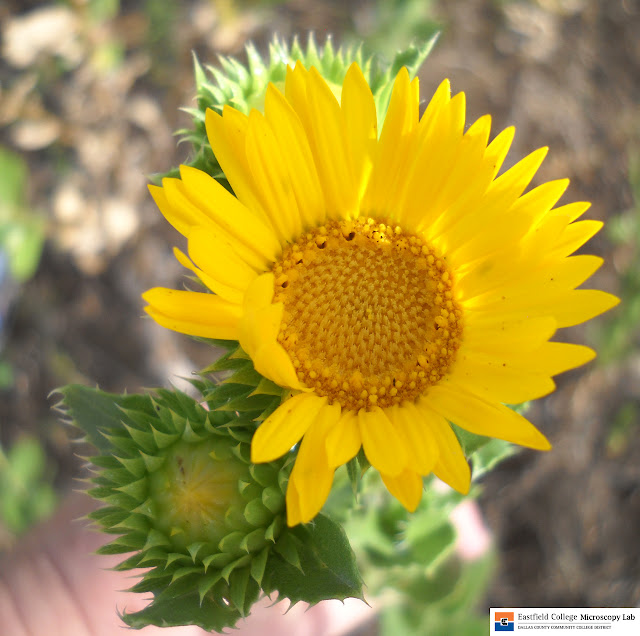The pitfall traps continue to yield little. The extreme heat over the last week (many 104 and 105 days) is causing rapid evaporation of the alcohol. Last week I added about 10 ml of glycerol to a liter of propanol to see if that would slow down the evaporation. In most traps all that is left is the glycerol. I know that I need to check the pitfalls much more often . Once my class starts if I have students who are interested in taking over the pitfalls we can work out a schedule for checking the traps more frequently.
I refilled the pitfalls and laid the tile cover right on the ground instead of having it suspended above the trap on pegs. The ground in this area is very uneven so there is still plenty of space for insects and spiders to enter, and this may help with the evaporation problem.
Interestingly, the traps farthest from the water (9 m) captured the most organisms - mainly small ground beetles and very small spiders.
My fascination with wildflowers continues. Despite what many folks may think, even in the extreme heat there are wildflowers blooming at TRAC. The Partridge Peas (Cassia fasciculata) are going strong. The student who was with me noticed that as the pea pods dry out they twist open to disperse the seeds. The empty pod halves look very much like DNA helices. I didn't get a photograph but will make a note to do so next week.
Lance-leaf Loosestrife (Lythrum lanceolatum)
 |
A very small flower but very striking. For scale notice that the length of my thumb nail just happens to be 1 cm.
|
Grassleaf Arrowhead (Sagittaria graminea var. platyphyla)
 |
Here you can see the flowers each containing 3 petals, one of the hallmarks of a monocot.
|
Sawleaf Daisy (Prionopsis ciliata)
 |
Sawleaf daisy with an unopened bud below.
|
 |
The unopened flower has its ray flowers tightly packed into a yellow dome. You can also see the spiked leafs that give this plant its name.
|
The Maximillian Sunflower (Helianthus maximilian)
 |
If you were to ask me what my favorite color is, I would probably never tell you yellow, but I will admit that I find sunflowers absolutely beautiful.
|
 |
In this image shows the leaves of the sunflower. Also notice the leaf at the bottom left of the image has an insect gall on it. (The shoes belong to a student.)
|
Funnel-Web Spiders
At the southeast end of the Great Egret Pond - which by the way had Great Egrets on it - if found some funnel-web spiders. (The trail along the western edge of Whistling Duck Pond also has many of these webs.)
 |
The arrow in this image shows the spider in the neck of the funnel - its retreat.
|
Another very good day at the Trinity River Audubon Center. Most of the time I feel like a kid in a candy shop - so many interesting things to choose from. Interestingly, lots of people who visit the Audubon center are there to look at birds. In my case, I spend most of my time looking down instead of up.
 All images are under a Creative Commons license. You are welcome to copy, retransmit, and modify these images all you want, but need to identify their source as Eastfield College, Mesquite, TX.
All images are under a Creative Commons license. You are welcome to copy, retransmit, and modify these images all you want, but need to identify their source as Eastfield College, Mesquite, TX.
Murry Gans
Microscopy Lab Coordinator
Eastfield College









